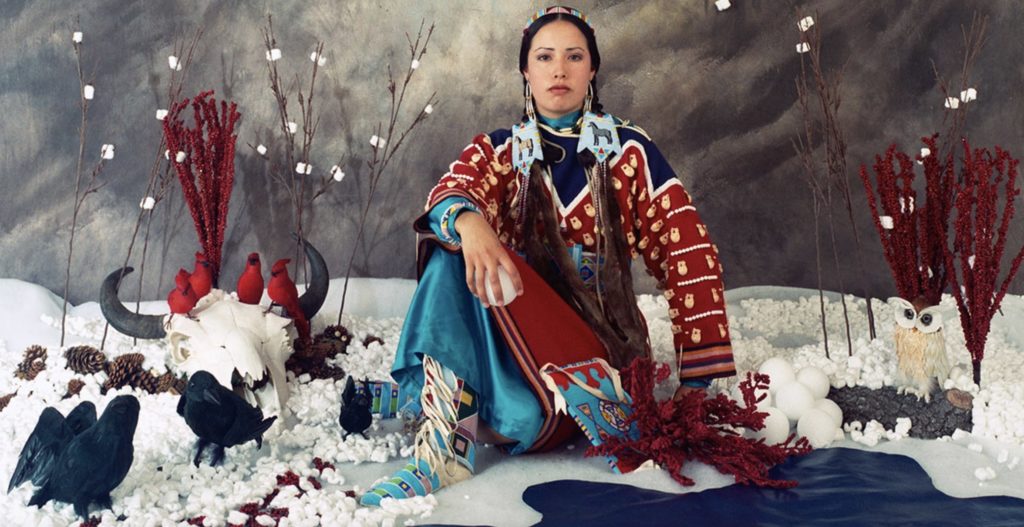How does Harry Potter relate to Native American life? Can you dress a car like a horse? Come find out at the Two Generations exhibit at the Schneider Museum of Art!
Whether you’ve been to the Schneider Museum of Art before or if this is the first time you’ve heard of the art museum on campus, the Two Generations exhibit, going on now until March 14, is a must-see. Featuring the two contemporary Native American artists Joe Feddersen and Wendy Red Star, this exhibit is full of pieces responding to misrepresentations of Native American life and culture. The pieces are beautiful, unexpected, and most of them have a humorous note that allows viewers to see new perspectives on modern Native American culture.
“I would argue that this work is very important,” says the museum’s Education Coordinator, Isabel Underwood, speaking about art by modern Native Americans, “especially in a contemporary art museum.” Owing to misrepresentations in American media, and even natural history museums, Underwood explains that a lot of people have certain images of Native American culture in their heads. Exhibits like Two Generations give Native Americans a voice and platform to share their experience being native.
Joe Feddersen, a member of the Confederated Tribes of the Colville Reservation, and has been exhibiting work around the world since the 1980s. He uses various art medias and combines modern urban symbols with native iconography to explore the relationship between indigenous life and the modern-day experience.

Photo by Clare DiMuzio
One of Feddersen’s pieces is a large glass mural entitled Charmed, which is a collection of free-hanging glass symbols. Displayed in this piece are indigenous symbols like teepees, horses, crosses, and representations of the elements mixed in with 21st century images like the Deathly Hallows and the golden snitch from Harry Potter, ice cream, airplanes, envelopes, and more. If you sit still in front of the piece and listen, you can hear the glass symbols gently tapping together to create a beautiful tinkling sound, music made as the old combines with the new. This piece, as explained by RYAN! Elizabeth Feddersen, Feddersen’s niece, is an invitation for viewers to critique their own expectations of what may be represented in Native American art.

Joe Feddersen’s piece Charms 
Joe Feddersen’s piece Charms
Wendy Red Star was raised on the Apsáalooke (Crow) reservation in Montana. Her work also combines indigenous images with a modern twist. The Schneider Museum of Art currently houses Red Star’s most well-known piece: the Four Seasons print series. These self-portraits were inspired when Red Star felt homesick while studying in Los Angeles and took a trip to the Natural History Museum in the hopes of finding Crow artifacts and some comfort. While at the museum, Red Star not only found the artifacts she was seeking, but also a shocking, artificial representation of her culture in a way that made it seem as dead as the stuffed coyotes on display. Red Star created the portraits wearing traditional Crow regalia and using intentionally ridiculous props (some of which still have the price tags). The humor and message in these portraits are hard to miss.

Photo by Clare DiMuzio
Another one of Red Star’s pieces not to miss is her print Iilaahee = car (goes by itself) + ii = by means of which + dáanniili = we parade. This print depicts three familiar vehicles: a RAM truck, a Subaru sedan, and a Ford truck, all covered (or “dressed”) in traditional Crow horse attire. Underwood points out that the backdrop to this print, and many of Red Star’s and Feddersen’s other pieces, are inspired by Pendleton blankets (which, according to Underwood, were originally designed to be marketed to the indigenous people in the US), which have significant meaning on the Crow reservation.

Photo by Clare DiMuzio
The Two Generations exhibit is a fun way to expand how viewers think about Native American culture and art in the modern world. It provokes introspection and investigation into commonly held beliefs about Native culture today. Underwood encourages viewers to come in with an open mind and expect the unexpected (pop-culture references, humor), and to take that open-mindedness into the world.
The Schneider Museum of Art is open Monday through Saturday from 10am to 4pm and is closed on Sundays. The museum is free and open to the public and is located near the Hannon Library on campus. There are free tours every Tuesday at 12:30, so definitely drop in if you’re on campus.



